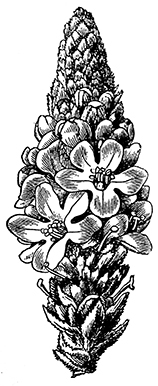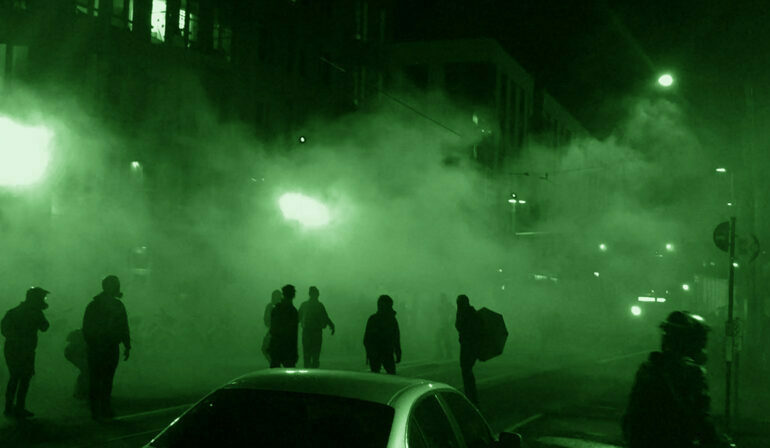If 2020 brought anything to my hometown of Portland, Oregon, it was the opportunity to be exposed to chemical weapons. Protesters, residents both housed and unhoused, bystanders, and workers throughout the city have been caught off guard by law enforcement’s prolific deployment of tear gas, pepper spray, and the like. Sometimes, the surprise has been in the timing or quantity–but other times, the chemical weapons (CW) used have changed from night to night, with differing colors or distinct effects. These tactics serve to spread fear and alarm, dissuading people from participating in the resistance.

For those of us on the ground, the treatment and decontamination procedures for these CW remain the same, regardless of the specific substance used. And when it comes to aftercare, symptoms dictate the course of action far more than the chemical composition of the toxins does. This piece is about aftercare: what to do in the hours, days, and weeks following your CW exposure once you’ve decontaminated and completed any necessary first aid interventions. Let’s sort it out by symptom, then, shall we?
[Before we get any further: Consider seeing a licensed health care practitioner as soon as possible if you are injured or exposed to CW because of police action. If you have lingering effects of CW or end up in a legal battle with the state, this kind of documentation can be very useful in the long run. In addition, licensed nurse practitioners, doctors, and other primary care practitioners can use their diagnostic tools to rule out serious medical issues stemming from your CW exposure or protest injuries. Call on mutual aid networks if things like money, transportation, or childcare are the only issues keeping you from needed health care. Your well-being is worth it!]
Dry, irritated respiratory tract
Sore throat, dry cough, lung soreness, painful sinuses, dry eyes
Dry conditions call for lubricating the mucosa. My favorite suggestion for this is to find a couple boxes of a tea blend with a name like “throat soother” or “throat coat” at the local natural foods store – they’re sure to contain moistening herbs like marshmallow (Althaea officinalis), violet (Viola spp.), and licorice (Glycyrrhiza spp.). You can also make your own tea blend of these herbs! I like to double up on tea bags, letting the infusion steep for a couple of hours when possible. Eating slimy foods like okra, chia seeds, or nopales is also a great (and delicious!) way to moisten respiratory tissue.
Inflamed or congested respiratory tract
Lung soreness, snotty sinuses, any cough, sore throat

Pretty much anyone who is exposed to CW will have some respiratory tract inflammation. For this, my go-to tonic is mullein leaf (Verbascum thapsus). This common plant is difficult for novices to identify, with some toxic look-alikes, but is easy and sustainable to grow and harvest – a worthwhile herbal remedy to get to know. It can be used as a tincture (plant material extracted into an alcohol base) or a tea. To make your own tea, grab a large handful of chopped dried or fresh mullein leaves, pour a quart of near-boiling water over it, cover, and let steep for a minimum of twenty minutes. When you’re ready to drink your mullein infusion, pour through a fine filter – a coffee filter or old cotton t-shirt work well – as mullein has very small hairs that can irritate the throat if not strained out. As the tea can taste bland, feel free to use sweetener and creamer as desired.
Another way to increase the palatability of mullein tea is to add an aromatic herb to the mix. This can be literally any plant that has a strong scent and a pleasant-to-you taste – think peppermint, lemongrass, cinnamon, or rosemary, for example. Aromatic plants not only help things taste good; they play an important role in CW recovery by acting as gentle expectorants. To that end, ingesting aromatic plants, whether in tea or in any other form, is a great idea to support the respiratory system. Eating aromatic and spicy foods like pesto, tom kha, or a picante salsa means ingesting volatile oils. When those volatile oils leave our bodies, one of the main ways they do that is through the respiratory system. On their way out, those aromatics gently irritate the mucosa that lines our airways, loosening it for excretion. Long story short, some of those CWs that you inhaled were trapped in your respiratory lining; drinking a warming chai or chowing down on some spicy greens will help you cough them back out.
All this respiratory tissue that I’ve been going on about. It functions best when it’s humid. If it’s dry out, consider running a humidifier or simmering a pot of water on the stove to moisten the air that you’re breathing. Or simply take as many steamy showers as you can handle. You can combine this intervention with aromatic herbs, of course; that water bubbling away on the stove can have a scoop of thyme, fir needles, orange peels, or lavender. With this, you’re humidifying the air, exposing your respiratory system to aromatics, and – wait for it – you’re also calming your nervous system by inhaling volatile oils from plants. Elegant aftercare, am I right?
Eliminatory systems support
Toxin exposure
Everyone who gets a dose of CWs should be thinking about supporting their eliminatory systems: digestion, kidneys, liver, lymph, lungs, and skin. This doesn’t look like a harsh detox diet, fasting, or anything extreme. What this does look like is some corny public service announcement for healthy living, or maybe an ad for a bougie spa retreat. Drink plenty of fluids – water, broth, herbal tea, coconut water, and other non-caffeinated, non-sugary, non-alcoholic drinks. Eat a rainbow of foods, with special emphasis on vegetables. Beans, whole grains, kale smoothies, chia seeds, and oatmeal are some of my favorite high-fiber foods to help carry toxins out of the body efficiently. Move your body: stretching, biking, yoga, silly dances, and relaxing walks in nature are all sound ideas. Sweat: saunas, cardio exercise, and hot baths can do the trick. Sleep as much as your body wants (aim for eight to ten hours if you can), at night when possible. Go easy on the sugar, alcohol, smoking, over-the-counter painkillers, and other drugs that you use, if feasible. Gentle massage and dry-brushing with motions toward the heart both give excellent support to the lymphatic system.
Liver support
Acne, hives, menstrual dysregulation, hormone imbalance, night sweats

There are a lot of one-size-fits-all recommendations floating around about herbs to support the liver and hormones after CW exposure. In my experience, there are few herbs that fit everyone across the board for these issues, and some liver- and hormone-supporting herbs can cause irritability, nausea, menstrual flooding, and other undesirable symptoms when taken by a person whose constitution doesn’t match the herb. Ideally, each individual would consult an experienced herbalist about such a protocol. In the meantime, there are some practices to support all kinds of bodies.
First, everything listed under “eliminatory systems support”: Do that. Focus on hydration, high-fiber foods, plenty of sleep at night, and avoiding alcohol and painkillers (like acetaminophen and ibuprofen) to whatever extent possible. If you like beets, beet greens, and chard, they are really supportive to liver function, so load up on borscht and feta-beet salads. Eat bitter foods (radicchio, dandelion greens, artichokes), try bitter teas (roasted chicory and dandelion root are classics), and avoid greasy food like chips and fries. When it comes to liver-supporting herbs, I recommend consulting with an herbalist, but if that’s inaccessible, folks with skin symptoms such as acne or hives might want to try a tincture of burdock (Arctium lappa, A. minus) root or seed. Those with menstrual and hormonal irregularities may find that dandelion root (Taraxacum officinale), yellow dock root (Rumex crispus), or artichoke leaf (Cynara scolymus) may be a key part of an herbal formula. And those who are returning to the streets, or otherwise risking further CW exposure, might decide to take milk thistle seed (Silybum marianum) as a tincture or in capsules to protect the liver.
Digestive issues
Sudden nausea, vomiting, cramping gut, loose stools
There have been nights in Portland when large portions of protesters who were exposed to CWs experienced extreme nausea or sudden vomiting. This symptom picture is disconcerting on its own; the fact that it was a different symptom picture than in days and weeks past would inspire me to seek professional medical attention if I were one of the people affected – CW use like that may be the subject of legal action, and if so, would need all the substantiating documentation it could get. Word on the street was that people were being encouraged to consume activated charcoal if they experienced vomiting. Unfortunately, this advice misses the mark: activated charcoal grabs onto toxins (and nourishing food) in the digestive system when it’s consumed and carries them out of the body before they can be digested. However, activated charcoal does nothing for toxins that were inhaled or absorbed through the skin, which is how CWs at protests are deployed. In cases like this, taking activated charcoal can do more harm than good, since it blocks the absorption and effects of any food or vitamins or medicines in the stomach while doing nothing to mitigate the harm that the CWs are causing. The best approach for digestive upset in such cases, barring any medical professional’s recommendations, is once again to support the eliminatory systems so that your body can process and clear the CWs as efficiently as possible. Vomiting or diarrhea additionally call for rehydration: plentiful water with electrolytes, whether in the form of coconut water, gatorade, or the World Health Organization’s rehydration formula.
Wounds
Minor burns, bruises, scrapes

Minor burns, once cooled and cleaned, benefit greatly from aloe gel (Aloe vera, Aloe spp.) applied topically. Both the fresh leaves (often found at groceries catering to Central American communities) or the bottled sunburn treatment yield gel that cools the area and promotes healing. Alternately, a compress of chilled tea of rose petals (Rosa spp.) or lavender flowers (Lavandula spp.) can be applied with a clean cloth to the burn to astringe the skin and provide mild pain relief. Hold the moist cloth to the burn for ten to twenty minutes, three to four times per day.
Minor bruises and scrapes can be treated with compresses as above, tinctures applied topically, or infused oils gently rubbed into the area. Wound-healing herbs like calendula flowers (Calendula officinalis), plantain (Plantago major & P. lanceolata), and yarrow leaves and flowers (Achillea millefolium) are excellent choices for all these applications. All three grow easily in temperate climates and are commonly found in shops that carry medicinal herbs. Avoid using comfrey (Symphytum officinale) unless under the care of an experienced herbalist. Monitor all wounds for signs of infection: increasing heat, tenderness, swelling; smelly pus; fever; and unexplained fatigue are some of the common symptoms to watch for.
Insomnia
Trouble falling or staying asleep
Sleep disturbances are a common reaction to ongoing stress and recent emotional trauma. It’s a symptom that asks us to take care of our emotional selves (see below) as much as we take care of our physical selves. In addition to generally supporting emotional, mental, and spiritual wellbeing, there are a lot of great tools for promoting sound sleep. The most basic is a wind-down ritual before bed. That can look like turning off screens for an hour before sleep, engaging in a mindfulness practice, reading a book, snuggling with human or animal loved ones, or gentle stretches, among other things. Sleep hygiene tools can help some people, too: not eating for a few hours before bed, ensuring that the bedroom is dark and quiet, using earplugs or eye masks, or sleeping alone are all possible interventions.

There are many safe and reliable herbs for sleep support. Two of my favorites are chamomile (Matricaria chamomila) and lavender (Lavandula spp.). Chamomile takes many people by surprise – they’re used to small tea bags of old, dusty herb that, when brewed, taste kind of lukewarm and bland. But recently dried chamomile flowers, sourced from a top-notch herbal company or a local farmer, can create a strong tea that is fruity, buttery, floral, and surprisingly sleep-inducing. Just like the mullein tea above, you’ll want to grab a large handful of dried or fresh chamomile flowers, pour a quart of hot water over the plant material, cover, and let steep for at least twenty minutes. Sweeten as desired. You’ll end up with a soporific brew that knocks most folks out. Chamomile can also be taken as a tincture, or you can even make a very strong tea and add it to a bath, soaking up the medicinal constituents through your skin.
Lavender makes a great bath as well, though a strong lavender tea is likely too bitter to drink much of. Enjoy an evening soak or use lavender either in tincture form or as an herbal sachet. Lavender works directly on the brain when smelled, which sends signals to the entire body to chill out and relax. This sachet technique can be used in the streets, as well, to calm down after a stressful experience.
Nervous system support
Anxiety, post-traumatic stress, depression, circular thoughts
It is absolutely normal to have symptoms of this nature after experiencing CWs. In fact, people can experience trauma reactions even if they weren’t attacked directly. Trauma reactions can happen to witnesses, friends and family of survivors, those who had close calls, and even folks who were exposed to the trauma through media or social media. It’s also totally okay not to have a trauma reaction after CW exposure. Every person is unique. If you experience symptoms of depression, post-traumatic stress syndrome, anxiety, or any emotional or mental symptom that interferes with your day-to-day life, it’s important to get professional support in addition to taking care of yourself. Talk therapy, EMDR therapy, mindfulness practices, and pastoral/spiritual guidance are just some of the options.
There are also some fantastic herbs that support the nervous system, providing both physical and emotional support through stressful times. Milky oats (Avena sativa) are one of my very favorites. When taken fresh in tincture form, milky oats nourish the nerves, providing a grounded, centered feeling and spreading a sense of calm. A safe and reliable tonic, milky oats are my top choice for folks who are prone to panic attacks or who feel frazzled or disembodied. Skullcap (Scutellaria lateriflora) is another great nerve tonic – again, best taken as a fresh-plant tincture – that helps to chill out and relax. Skullcap is a great pick for folks with tight shoulders and an inability to rest. Both of these plant allies are wonderful to take for weeks or months as part of a nervous system rejuvenation protocol, but they also work in the moment when a deep breath is needed.
In the streets and beyond:

Fight the power and do no harm!
When we take care of ourselves and take care of each other, we nourish a stronger base for creating change. Don’t overlook the benefits of aftercare – both our bodies and our spirits need tending when we come up against state violence. It may be tempting to operate continuously at 110 percent during times of civil uprising, but any successful push for change is long and, at times, grueling; prepare to be in it for the long haul, and please don’t burn out.
The street medic collective I was in, the Black Cross Health Collective, had as our motto, “Fight the power and do no harm!” In that spirit, only implement the ideas in this article if they feel good for your body, and if they aren’t contraindicated for you. Consult your health care provider or a knowledgeable herbalist if you have a health condition or if you have any questions about your aftercare. And then, once you’re recharged and well, step back in and cause some good trouble!
Missy Rohs is a community herbalist in Portland, Oregon. These days, she channels her lifelong passion for education and rabble-rousing into the Arctos School of Herbal & Botanical Studies. Missy believes in the power of weeds and the importance of community.
– This guide is contained in the Power issue of Perspectives on Anarchist Theory, available here!

